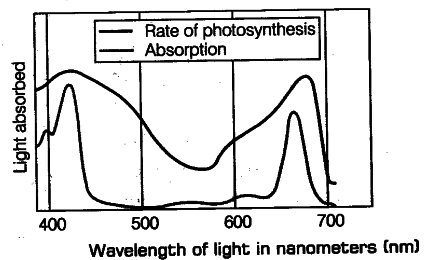In the figure given below, the black line (upper) indicates action spectrum for photosynthesis and the lighter line (lower) indicates the absorption spectrum of chlorophyll-a, answer the followings.
(i) What does the action spectrum indicate? How can we plot an action spectrum? Explain with an example.
(ii) How can we derive an absorption spectrum for any substance?
(iii) If chlorophyll-a is responsible for light reaction of photosynthesis, why do the action spectrum and
absorption spectrum not overlap ?

(i) The effectiveness of different wavelengths of light on photosynthesis is measured and plotted the amount of action. This is called the action spectrum of photosynthesis.
(ii) Absorption of different wavelengths of light by a particular pigment is plotted and is called the absorption spectra of that pigment.
(iii) Chlorophyll-a is responsible for light reaction of photosynthesis, but the action spectrum and absorption spectrum do not overlap because, though chlorophyll is the main pigment responsible for absorption of light, other thylakoid pigments like chlorophyll-i, xanthophylls and carotenoids, which are called accessory pigments, also absorb and transfer the energy to chlorophyll-a. Indeed they not only enable a wider range of wavelength of incoming light to be utilised for photosynthesis but also protect chlorophyll-a from photooxidation.